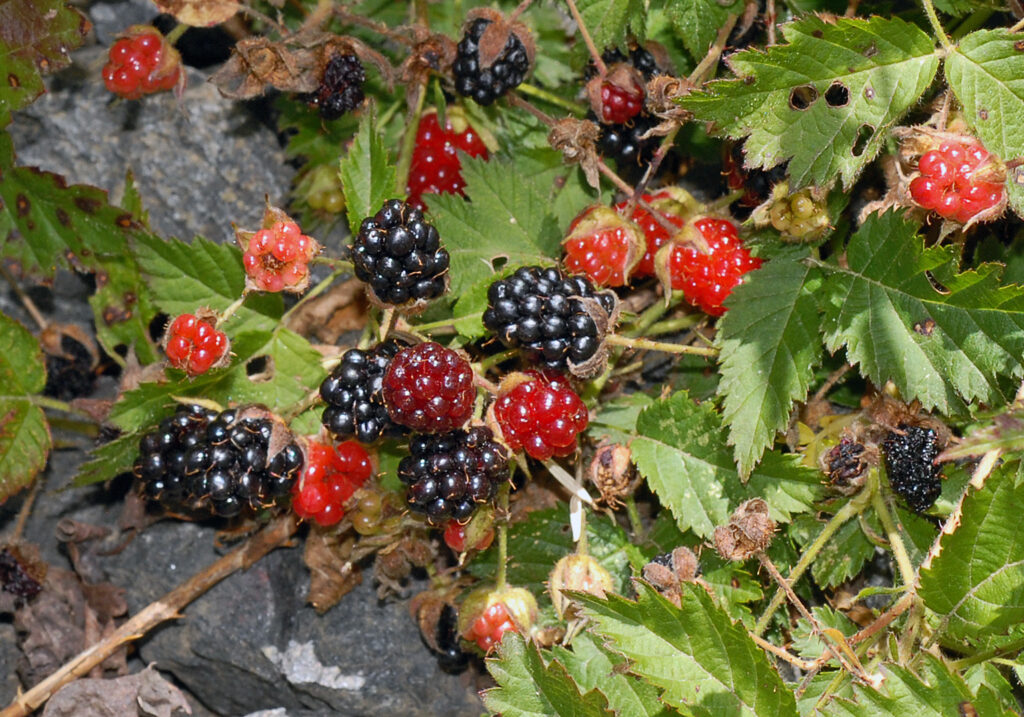
Berries of the Preserve
September 25, 2023
by Amanda Campos, Communications Intern
Berries are loved by humans and animals alike. Conventionally, we use “berry” to describe any small, fleshy, and edible fruit. However, the botanical definition of a true berry is a fruit produced from one single flower with one ovary, typically having many seeds. So, scientifically speaking, bananas are berries, while strawberries are not! Still, in this article, we will follow the commonplace, generic definition to check out some of the popular sugary treats of the wild.
In the Santa Lucia Preserve, native berries play significant ecological roles. They are valuable food sources for birds and various mammals – especially for nonmigratory birds during colder weather when insects are scarce. Native berries are particularly healthy, as they often contain more of the carbohydrates, fats, and nutrients birds need than invasive fruit-bearing plants. The energy supplied by berries provides important fuel to migratory birds on their long journeys. It is a win-win situation for all parties, of course, as berry-eaters are crucial for seed dispersal.
In the late summer on the Preserve, you can spot many of the berries below. The red baneberry and common snowberry, for example, are often found in redwood and oak forest habitats. Here is a tour of six berries at The Santa Lucia Preserve.
Red baneberry (Actaea rubra)

Photo by Amanda Campos
From its stems to its fruits, red baneberries are poisonous to humans but benign to birds. This herbaceous (nonwoody) plant can be found in slopes and open forests, in shady spots with moist soil. Its white compound flowers appear during spring and early summer, with red berries following in late summer.
Red is a common color for berries; the hue provides a natural contrast to green leaves and makes the fruit easy for birds and animals to spot.
Common Snowberry (Symphoricarpos albus)

Photo by Amanda Campos
An exception to the red-berry rule, snowberries are white when ripe and are enjoyed by birds and browsers like deer, but they are toxic to humans. Though inedible, the fruit contains the chemical saponin, a natural antimicrobial and antioxidant, and Native Americans have long used the berries topically to treat burns and rashes. Though they produce small pink flowers early in the year, common snowberries primarily reproduce through vegetative (asexual) reproduction: that is, new plants grow by spreading from an underground reproductive organ called a rhizome. With sturdy wooden stems, dense groupings of snowberries are common.
Trailing blackberry (Rubus ursinus)

Photo by Curtis Irish.
Also known as California or Pacific blackberry, this small fruit is sweet and safe for humans and animals alike, although its numerous prickles may be scratchy. This shrubby vine can grow up to 5 feet high, spreading easily and rapidly wherever there is moisture – primarily in woodlands. Like holly and mistletoe, this plant is dioecious — that is, it produces both male and female plants — but only females bear fruit. Additionally, it can propagate through vegetative reproduction when its thorny branches take root in the soil. The bush puts out fragrant white flowers in winter and spring, with berries setting on the stems soon after.
Fuchsia-flower gooseberry (Ribes speciosum)

Photos by NatureShutterbug (above) and J. Maughn (below).
Growing up to 10 feet high and 8 feet across, the fuchsia-flower gooseberry is a memorable sight in bloom, producing distinctive elongated scarlet blossoms with protruding stigmas and stamens (female and male reproductive parts, respectively) like its namesake (but distantly related) fuchsia. Blooms can appear as early as January, once leaves have emerged. The plant is summer deciduous, so during California’s hot and dry months this shrub is left with only its thorny stems and ripening berries. Preferring shady and seasonally moist spots, the fuchsia-flower gooseberry can be found in both drier climes like chaparral and coastal scrub as well as woodlands. Its reddish, bristly berries are particularly important for hummingbirds and are edible for humans.

Thimbleberry (Rubus parviflorus)

Photo above by John Haley. Photo at top of page by Ruth Hartnup.
The diminutive thimbleberry is likely named for its appearance. A hollow, raspberry-like fruit, its shape resembles a sewing thimble. Unlike other rubus shrubs (the genus of blackberries and raspberries), the plant does not have thorns. Rather, its bright green leaves are fuzzy and soft. Both birds and bears eat thimbleberry fruit, while mule deer browse on its stems and young leaves. Ironically perhaps, the plant’s five-petaled white flower is the largest in the rubus genus and gives way to small edible berries in mid-to-late summer.
Coffeeberry (Frangula californica)

Photo by Amanda Campos.
While they’re no substitute for the beans that brew your morning cup of Joe, coffeeberries are named for their strong resemblance to coffee beans. The plant is notably adaptable, tolerating a variety of soils and thriving in full sun or partial shade. In optimal conditions, this evergreen shrub can grow to a tree size of 12 feet, but it is usually about six feet high. Native American people of the West Coast have used coffeeberries medicinally; the Ohlone people have applied the berries to rashes caused by poison oak, while the Kawaiisu have used the pulp for wound treatment. The berries are edible and ripen between August and October after tiny green-and-white flowers appear in earlier months.
It’s all ‘berry’ interesting!
Berries are highly valued by humans and wildlife alike. Our native berry plants benefit pollinators, birds, mammals like rabbits, bears, and deer, and the many others using them for both food and shelter.
Note that eating any plant or fruit found in the wild is not recommended: Nature may have provided even the most appetizing berries for birds alone, rather than humans. Yet, while we may not consume the fruit, we can appreciate the berry’s outsized role in the ecosystem.